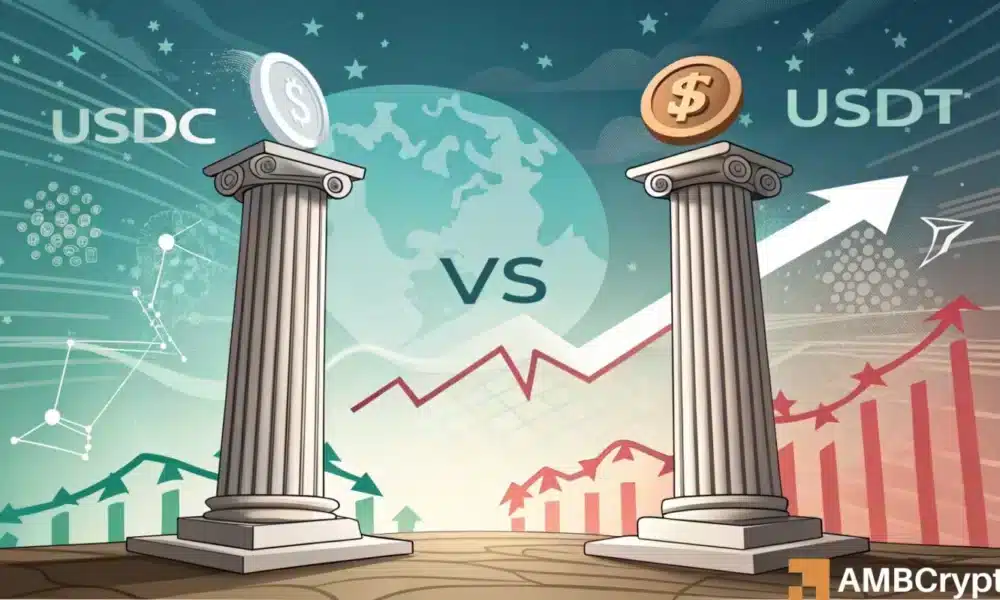The Resurgence of Stablecoins: A Deep Dive into DeFi’s Revival
In July 2025, stablecoin on-chain volume soared to an unprecedented $1.5 trillion, marking a pivotal moment for decentralized finance (DeFi). This surge, the highest monthly total recorded, indicates a potent revival in DeFi activities primarily driven by Ethereum’s robust performance and newfound regulatory clarity following the passage of the U.S. GENIUS Act. As investors and users flock to decentralized platforms, this article explores the key factors contributing to the resurgence of stablecoins, illustrating their increasing importance in the DeFi landscape.
Stablecoins and the DeFi Landscape
The recent spike in stablecoin activity underscores their indispensable role in supporting DeFi transactions. Blockchain analytics firm Sentora noted that the remarkable jump from January’s $950 billion firmly positions stablecoins as essential instruments for users navigating the decentralized economy. Not only does this growth signify renewed interest in decentralized exchanges and lending platforms, but it also showcases the evolving dynamics within the crypto space. With almost $200 billion generated in just the first five days of August, forecasts suggest that monthly volumes could exceed $1.2 trillion, underscoring a resurgent DeFi ecosystem.
The Impact of Ethereum’s Performance
A significant driver behind this surge has been the remarkable performance of Ethereum, which has experienced a renaissance, spurring investors’ confidence. As ETH prices climb toward the $4,000 mark, a corresponding increase in the Total Value Locked (TVL) in DeFi protocols has been observed, hitting a three-year peak of $179 billion. This correlation emphasizes the integral relationship between stablecoins and Ethereum, which functions as the backbone of many DeFi projects. Liquid staking protocols, in particular, have witnessed increased inflows, further fueled by Ethereum’s bullish momentum.
Leading Players: USDC vs. USDT
As the DeFi market rebounds, stablecoins are becoming increasingly essential. Circle’s USDC has emerged as a leading player in DeFi transactions in 2025, contributing between 40-48% of the total on-chain stablecoin volume. In contrast, Tether’s USDT and MakerDAO’s DAI contribute smaller portions, ranging from 20-27% and 17-33%, respectively. Collectively, these three stablecoins dominate over 90% of monthly on-chain activity, highlighting the significance of stablecoins in maintaining liquidity and enabling transactions within the DeFi ecosystem.
Shifts in Supply and Demand Dynamics
While USDC takes the lead in transactional volume, USDT remains the largest stablecoin by supply, commanding a market dominance of 61.41% with a circulating value of approximately $164.70 billion. This resurgence in on-chain demand for USDT is particularly evident on lending platforms like Aave, where the supply of USDT has increased by an impressive 123% since the year’s start, approaching $7.5 billion. This reflects a broader trend of stablecoins regaining traction as more users leverage them for DeFi transactions, lending, and yield farming.
Security Concerns and Growth Strategies
Despite USDC’s leading position, scrutiny over security has emerged, especially following incidents where users lost significant amounts due to scams tied to contract approvals. However, Circle is not resting on its laurels; the company is actively pursuing growth strategies. With an ambitious public offering aiming to raise up to $624 million and achieve a fully diluted valuation of $6.7 billion, Circle is positioning itself for sustained growth in the evolving DeFi landscape. This strategic move signals confidence in USDC’s future role as a cornerstone of decentralized finance.
Conclusion: The Future of Stablecoins in DeFi
The meteoric rise of stablecoin volume in July 2025 is a compelling indicator of a vibrant resurgence in DeFi, propelled by Ethereum’s ascent and favorable regulatory developments. As the market continues to evolve, the competition between USDC and USDT plays a critical role in shaping user preferences for on-chain transactions. With increasing adoption, burgeoning use cases, and ongoing innovations, stablecoins are likely to remain a fundamental component of the DeFi ecosystem as they facilitate transactions, enhance liquidity, and attract both institutional and retail investors looking to capitalize on this expanding space. As the landscape matures, it will be fascinating to observe how these digital assets navigate the challenges and opportunities ahead.


